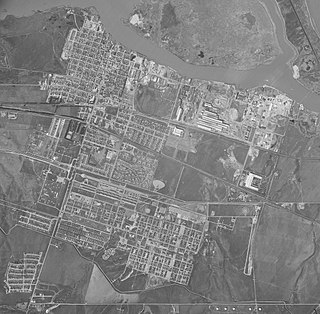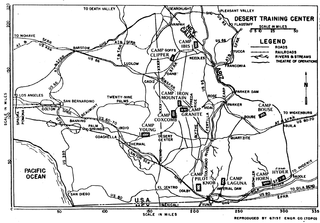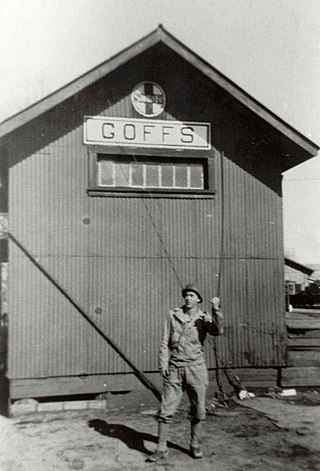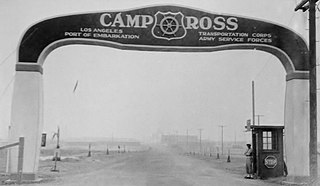
The General George S. Patton Memorial Museum, in Chiriaco Summit, California, is a museum erected in tribute to General George S. Patton on the site of the entrance of Camp Young, part of the Desert Training Center of World War II.

The San Francisco Port of Embarkation (SFPOE) was a United States Army command responsible for movement of supplies and troops to and from the Pacific during World War II with extensive facilities in the San Francisco area. SFPOE was established 6 May 1932 and disestablished 1 October 1955. It was originally composed of the long term Pacific terminal at Fort Mason that had been the home port and terminal for the Pacific Army Transport Service ships. That facility was far too limited to serve the requirements of a full port of embarkation. In 1940 the port began expansion to include Army owned and leased facilities throughout the San Francisco Bay area and for a time sub ports at Seattle and Los Angeles. Those eventually became separate commands as the Seattle Port of Embarkation and Los Angeles Port of Embarkation.

The Boston Port of Embarkation (BPOE) was a United States Army command responsible for the movement of troops and supplies from the United States to overseas commands. In World War I it was a sub-port of the New York Port of Embarkation. During World War II it became an independent Port of Embarkation with the second greatest number of passengers embarked and third greatest tonnage of cargo embarked by east coast Ports of Embarkation. In passengers it was exceeded on the east coast only by New York and in cargo only by New York and the Hampton Roads Port of Embarkation. Within three months after entry of the United States into World War II Boston was being established as a sub-port of New York. With establishment of the United States Army Transportation Corps in March 1942 the Boston sub-port became the independent Boston Port of Embarkation.

The Army Service Forces was one of the three autonomous components of the United States Army during World War II, the others being the Army Air Forces and Army Ground Forces, created on 9 March 1942. By dividing the Army into three large commands, the Chief of Staff, General George C. Marshall, drastically reduced the number of officers and agencies reporting directly to him. The Army Service Forces brought together elements of five different components of the Army: elements of the War Department General Staff (WDGS), especially its G-4 division ; the Office of the Under Secretary of War; the eight administrative bureaus; the nine corps areas, which became service commands; and the six supply arms and services, which became known as the technical services. The Army Service Forces was initially known as the United States Army Services of Supply but the name was changed on 12 March 1943, as it was felt that the term "supply" did not accurately describe the broad range of its activities. The Army Service Forces was abolished on 11 June 1946 and most of its functions were taken over by the War Department General Staff.

Camp Stoneman was a United States Army facility located in Pittsburg, California. It served as a major troop staging area for and under the command of the San Francisco Port of Embarkation (SFPOE). The camp operated during World War II and the Korean War.

The Desert Training Center (DTC), also known as California–Arizona Maneuver Area (CAMA), was a World War II training facility established in the Mojave Desert and Sonoran Desert, largely in Southern California and Western Arizona in 1942.
Brent Prescott's Camp Ono existed from 1942 to 1947 in Southern California on 300 acres of land. The camp was four miles northwest of the City of San Bernardino, California.

Camp Ibis was one of twelve divisional tent camps of the US Army Desert Training Center (DTC) which was established in early 1942 during World War II, originally to advance desert tank warfare and to train troops for desert combat. The DTC was located in the Mojave Desert and Sonoran Desert, largely in Southern California and Western Arizona. In October 1943, the DTC was redesignated as the California-Arizona Maneuver Area (C-AMA). The headquarters for the Desert Training Center was Camp Young where General Patton's 3rd Armored Division was stationed. Camp Ibis was designated a California Historic Landmark. The site of the Camp Ibis 8 miles (13 km) East of Needles, California off Highway 95, north of Interstate 40 in San Bernardino County, California. The camp was originally named after the Ibis railroad siding in Piute Valley. The camp was located at the west side of the Dead Mountains Wilderness.

The Temporary Detention Camp for Japanese Americans / Pomona Assembly Center is one of the places Japanese Americans were held during World War II. The Pomona Assembly Center was designated a California Historic Landmark on May 13, 1980. The Pomona Assembly Center is located in what is now called the Fairplex in Pomona, California in Los Angeles County. The Pomona Assembly Center was called Los Angeles County Fairgrounds in 1942.

The Camp Coxcomb was a sub camp of the US Army Desert Training Center in Riverside County, California. The main headquarters for the Desert Training Center was Camp Young where General Patton's 3rd Armored Division was stationed. Camp Coxcomb was designated a California Historic Landmark (No.985). The site of the Camp Granite is 45 miles East of Indio, California off Interstate 10 and California State Route 177 near the Coxcomb Mountains. The train stop at Freda railroad siding delivered Troops and equipment. The camp closed in early in 1944 after about two years of operations.

Camp Clipper and Camp Essex were subcamps of the US Army's Desert Training Center in San Bernardino County, California, located near Historic Route 66 and the Santa Fe Railway. The main headquarters for the Desert Training Center was Camp Young. This is where General George S. Patton's 3rd Armored Division was stationed. Camp Clipper was designated a California Historic Landmark (No.985.5). The site of Camp Essex is located near the Fenner Rest Area in Fenner, California, on Interstate 40 and Route 66, 32 miles (51 km) west of Needles in San Bernardino County, California, near the town of Essex. Currently at the south end of the Mojave National Preserve. Camp Clipper was just to the west of Camp Essex. Camp Essex was a temporary camp for incoming and outgoing troops. Camp Essex was named after a small town near the camp, Essex. Camp Clipper was named for its proximity to the Clipper Mountains. Between Camp Essex and Route 66 was the 4,500 foot Camp Essex Army Airfield.

The Camp Iron Mountain was a sub camp of the US Army Desert Training Center in Riverside County, California. The main headquarters for the Desert Training Center was Camp Young; this is where General Patton's 3rd Armored Division was stationed. Camp Iron Mountain was designated a California Historic Landmark (No.985.6). Camp Iron Mountain is near the site of Camp Granite, both are 45 miles (72 km) miles East of Indio, California off Interstate 10 and California State Route 62 near the Granite Mountains in San Bernardino County, California. In 1980 Camp Iron Mountain received the listing as an Area of Critical Environmental Concern from the Bureau of Land Management. The listing was given as Camp Iron Mountain is the best preserved of the Desert Training Center Camps. The Bureau of Land Management put up fences to protect the camp from Off-road vehicle traffic. Still at the camp today are a 200 x 175 foot contour training map, some rock mosaics, two church altars, rock lined roads and walkways. The camp is named after the near by Iron Mountains.

The Camp Desert Center was a sub camp of the US Army, Desert Training Center in Riverside County, California. The main headquarters for the Desert Training Center was Camp Young, where General Patton's 3rd Armored Division was stationed. Camp Desert Center was at Desert Center, California, in Riverside County, California in the Colorado Desert.

The Camp Goffs was a sub camp of the US Army Desert Training Center in Riverside County, California. The main headquarters for the Desert Training Center was Camp Young, this is where General Patton's 3rd Armored Division was stationed. Camp Goffs was designated a California Historic Landmark (No.985). The site of the Camp Goffs just north at the former Santa Fe Railroad station at Goffs, California. Goffs, California is on U.S. Route 66 5 miles north of the current Interstate 40, 25 miles (40 km) west of Needles in San Bernardino County, California. Currently at the south east end of the Mojave National Preserve. Camp Goffs was 20 miles southeast of Camp Essex and Camp Clipper.

Camp Ross was a World War II base serving as a staging area under the command of the Army's Los Angeles Port of Embarkation. The camp was located in San Pedro, California and Wilmington, California. The United States Department of War leased 31.026 acres of land starting in 1942. Camp Ross was used by the US Army as staging area for troops ready for deployment and for troop returning home to Naval Operating Base Terminal Island.

California during World War II was a major contributor to the World War II effort. California's long Pacific Ocean coastline provided the support needed for the Pacific War. California also supported the war in Europe. After the Japanese attack on Pearl Harbor on December 7, 1941, most of California's manufacturing was shifted to the war effort. California became a major ship builder and aircraft manufacturer. Existing military installations were enlarged and many new ones were built. California trained many of the troops before their oversea deployment. Over 800,000 Californians served in the United States Armed Forces. California agriculture, ranches and farms were used to feed the troops around the world. California's long coastline also put the state in fear, as an attack on California seemed likely. California was used for the temporary and permanent internment camps for Japanese Americans. The population grew significantly, largely due to servicemen who were stationed at the new military bases/training facilities and the mass influx of workers from around the U.S. in the growing defense industries. With all the new economy activity, California was lifted out of the Great Depression. Over 500,000 people moved to California from other states to work in the growing economy. California expanded its oil and mineral production to keep up with the war demand.

Camp Seeley' was a United States Army World War II training camp near El Centro, California in the Imperial Valley. At Camp Seeley was: the Camp Seeley Combat Firing Range, Camp Seeley Ordnance Desert Proving Ground and Camp Seeley Ordnance Training Center. The 17,574 acres Camp Seeley was 10 miles northwest of the City of El Centro, near the city of Seeley, California. The town is named after Henry Seeley, a pioneer of the Imperial Valley. The camp was north of what is now California State Route 98. The tent camp, in the Yuha Desert, opened November 1940, first based at the camp was the 11th Cavalry Regiment, the troops and Army horse came from the Presidio of Monterey, California. At the camp the 11th Cavalry Regiment took part in desert training and teaching horses to swim across rivers with rider. 11th Cavalry Regiment moved to Camp Lockett at Campo, California in December 1941. The 11th and 28th Cavalry Regiment also trained at the camp, along with the 75th Horse Field Artillery Battalion. In 1942 Camp Seeley was converted to a US Army ordnance proving ground. While the camp is closed the area of Camp Seeley the home of the Historical "The Colonel's Own." 11th Cavalry Horse Honor Guard.

Camp Haan was a US Army training camp built in 1940, near March Air Force Base in Riverside County, California Camp Haan was opened in January 1941 as a training camp for Coast Artillery Antiaircraft gunners. The 8,058 acres camp was about four miles by three miles with tent housing. The camp was named after Major General William George Haan of World War I. By the end of 1941, the camp had a wood service building, 28 miles of streets, five chapels, and a hospital. The first troops trained were sent for the defense of Los Angeles and San Francisco. The Attack on Pearl Harbor and the Battle of Los Angeles–Bombardment of Ellwood had put all of California on high alert. The Army Service Depot was added to the camp in March 1942. The site of the former Camp Haan is next to California Interstate 215 at the Van Buren Boulevard exit.
The Italian Service Units or ISUs were military units composed of Italian prisoners of war (POWs) that served with the Allies during World War II against Nazi Germany and the Empire of Japan from May 1944 to October 1945. The armed forces of the United States captured many Italian soldiers during the North African campaign Operation Torch, which started in November 1942 and sent 51,000 of them to the United States. After the signing of the armistice by the Badoglio government in Italy on September 8, 1943, and with Pietro Badoglio and the Kingdom of the South officially declaring war on Nazi Germany on October 13, 1943, the Americans began to see the POWs as potential allies. The capture of Rome by the Allies on June 4, 1944, motivated many POWs to change sides. About 90% joined Italian Service Units, which operated in the United States and overseas.
Needles Station Hospital was US army Hospital built to support the training at the camps of the vast World War II Desert Training Center. Needles Station Hospital was located in the City of Needles, California in San Bernardino County, California. The main headquarters for the Desert Training Center was Camp Young where General Patton's 3rd Armored Division was stationed. Needles Station Hospital was on 875 acres of land and was open from 1942 to 1943. The hospital had two 250 bed hospital units. The hospital and camp was built using temporary buildings. Due to a shortage of manpower, Prisoner of War at the Hospital Camp volunteered to work at the hospital. The land was transferred back to the Department of the Interior on December 16, 1944. The site today is a mix of open land and housing. The Federal Property ID number is J09CA0507.




















